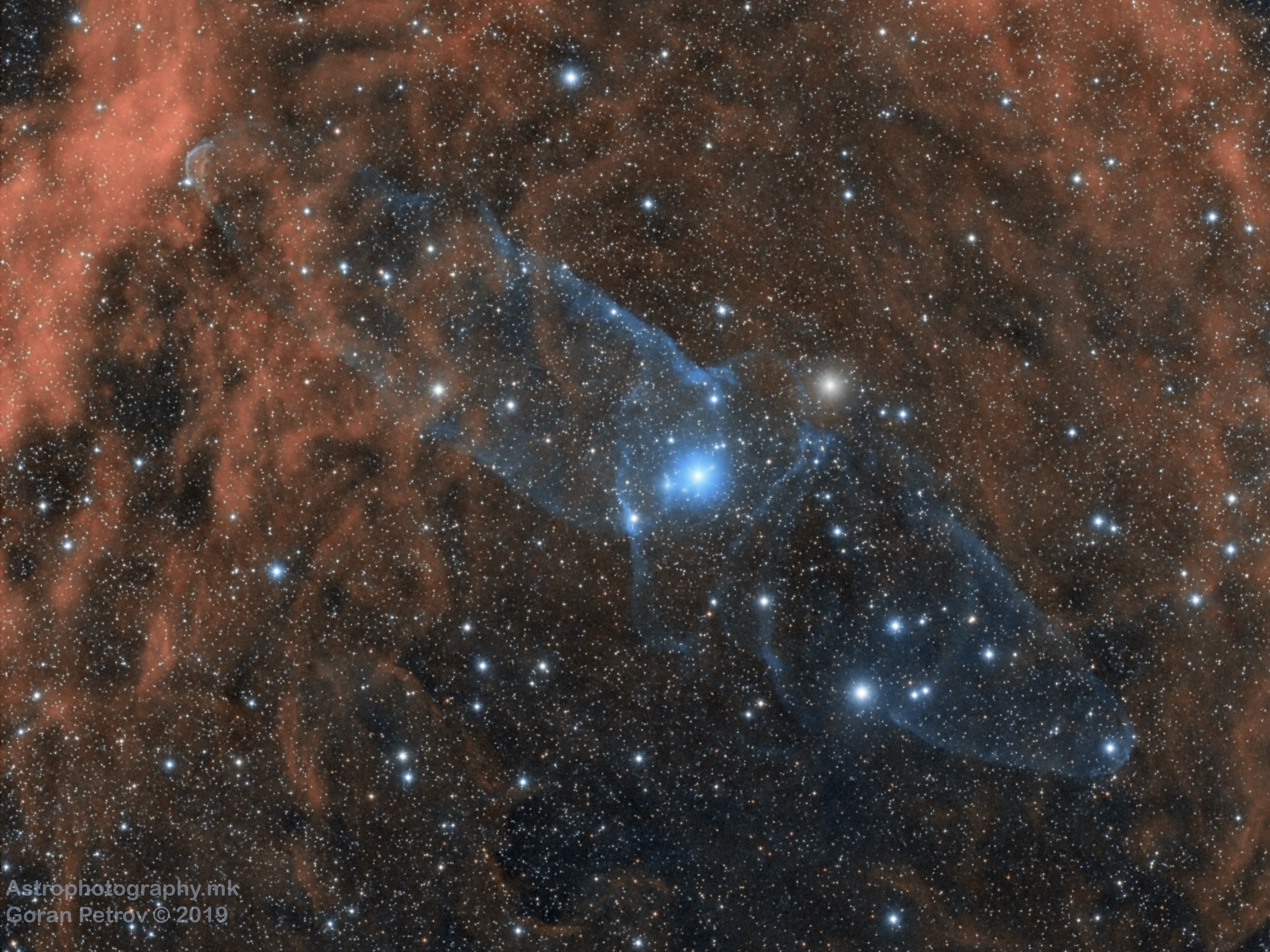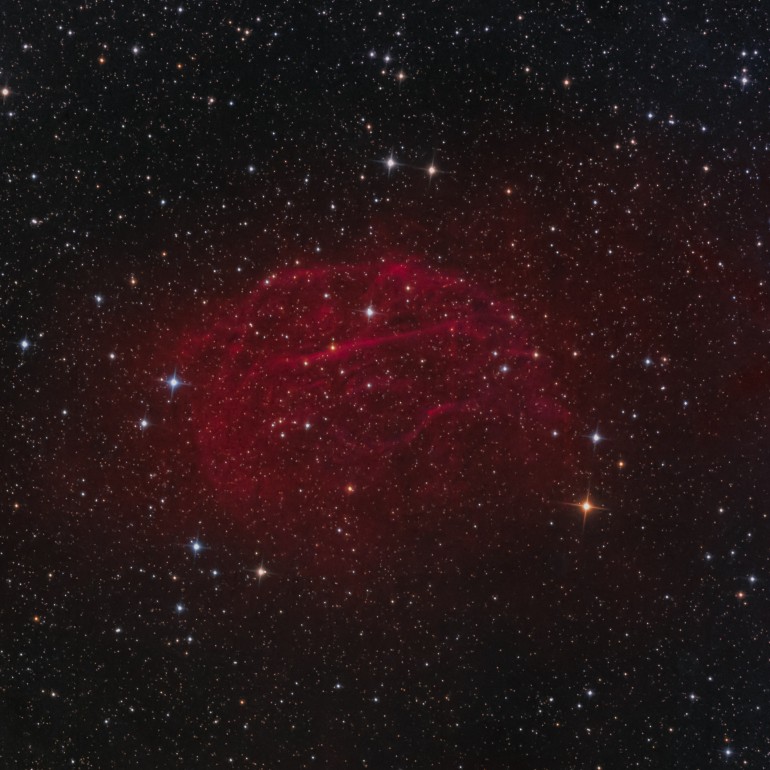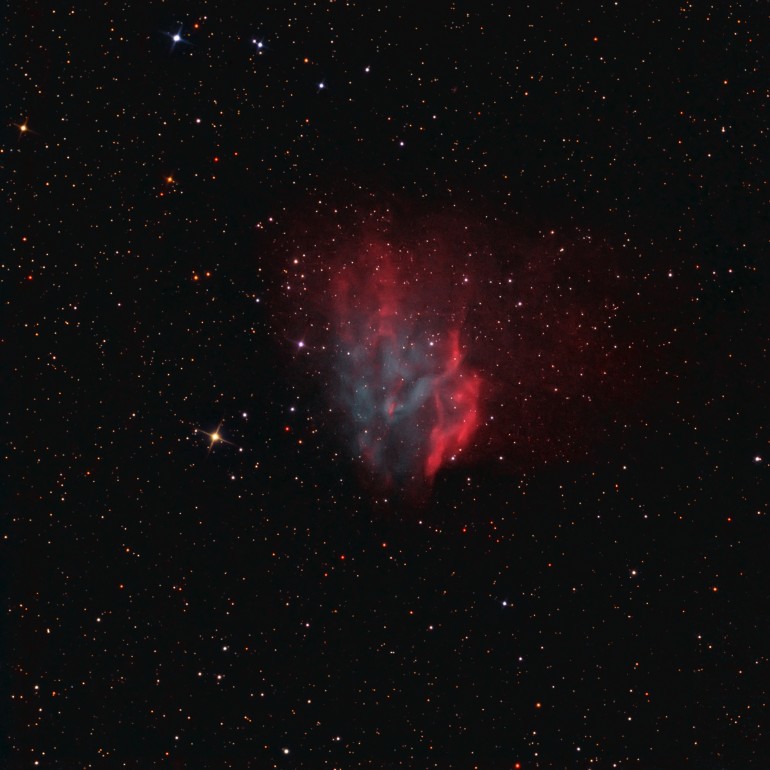Two other visual observers, Peter and Jamie, were there. Around five more were imagers. Unfortunately they talked non-stop, smoked cigars, and drank through the night. Worse, they were very bad with their light control. Not having to protect one's dark adaptation makes one careless. I missed the quiet and solitude of Willow Springs.
It took me a while to settle down to observe, so I started out scanning about a little randomly, doing a mini Messier tour. M101 to start, round and diffuse but no structure. M51, two bright nuclei but diffuse halos without structure otherwise. M109, with NGC 3953 in the same field. M97 & M108 in the same field. Markarian's Chain and other galaxies in Virgo I didn't take the time to identify. M4 in Scoprius, and I had a look at IC 4604 which was a little disappointing -- large irregular oval of faint cloudiness. M80 small and bright. Then a string of globulars: M107, M10, M12, NGC 6426, M14, and NGC 6366. Also the large and bright open cluster IC 4665, an engaging arrangement of twenty bright white stars with many fainter behind. M7 looked really great, along with M6 and all the other nebula and star clouds and dark nebula in the milky way. A line of globulars at the base of the tea kettle: M69, NGC 6652, M70, M54, and of course M22 and M28. M13. M57 bracketed by Sulafat and Sheliak star fields. And so it went, enjoying the view and not recording anything.
Around midnight some of the imagers started to depart, and all had left by 1am. It became rather cold, in the low 40s. I decided to try for some more unusual targets.
UMi Dwarf, UGC 9749, 10-inch 35x: This was a fairly easy hop from Gamma UMi. The galaxy was positioned as the third point of a triangle with two bright stars, and two fainter stars acted as a pointer. The galaxy appeared as a large oval graininess, about half a degree long at it's major axis, NNW-SSE. It was slightly brighter than the surrounding sky and was noticed while nudging the scope to keep the field in view. It did not take long to see this, and did not seem very difficult. [In 1999, Kenneth Mighell and Christopher Burke used the Hubble Space Telescope to confirm that the Ursa Minor dwarf galaxy had a straightforward evolutionary history with a single burst of star formation that lasted around 2 billion years and took place around 14 billion years ago, and that the galaxy was probably as old as the Milky Way itself.]
https://en.wikipedia.org/wiki/Ursa_Minor_Dwarf

Draco Dwarf, UGC 10822, 10-inch 35x: This was about 2x larger than UMi, fainter, also appeared as a brownish graininess versus the black sky; its shape was much more difficult to tell, the edges were very diffuse. After some time viewing it appeared the center of the area was marginally brighter than the rest of the grainy area. [Having an absolute magnitude of -8.6[c] and a total luminosity of only 2×105 L☉, it is one of the faintest companions to our Milky Way.] https://en.wikipedia.org/wiki/Draco_Dwarf

Outers 4 & Sh 2-129: 10-inch 35x: Outers 4 is nearly centered on STF 2780, which in the field is part of a triangle of similar magnitude stars, including a pretty orange star V419 Cep. With OIII I detect a extremely faint arc connecting the STF 2780 AB (not split, 1") with another nearby star to the SW (9th mag HD 239600); there is a non-stellar (or maybe just a very faint star) in the center of this. It appears, from astrophoto, I detected the very center and brightest part of the object, where two lobes originate. I did not see anything of the lobes. It was discovered in 2011 by French ameteur Nicolas Outers, and is not a planetary nebula; it is thought to be either a protostar or a post-AGP star (for more info & picture see https://astrophotography.mk/the-giant-squid-nebula-outter-4/.) Sh 2-129 was quite easy with Hbeta filter and is a large, 2 degree "C" arc, either ends of which are brighter and thicker than the middle, with some wispy detail.

IsWe2: Ishida-Weinberger 2: 10-inch, 35x: Large irregular haze, mostly round, about half a degree in extent, in a triangle of stars. It's a subtle haze overlaid on the dark sky background. I can detect with difficulty with OIII but its presence is much stronger with HBeta. I saw one star inside the glow and very close to it a non-stellar point -- which is probably just a faint star not the central star. [Ishida Weinberger 2 (IW2, PK 108+08) is a large, ancient, ellipsoidal planetary nebula (PNe) in the constellation of Cepheus, and is about 850 light years distant (Ishida and Weinberger, Astron. Astrophys. 178, 227—236, 1987). It appears to be slightly elongated in the NW-SE direction encompassing about 18.5’ (north is toward the upper right). The field is 32’ x 32’. From the expansion velocities of H-a and NII, IW 2 is estimated to have a kinematic age of about 40,000 years. It is quite faint but emits both H-a and NII, but no detectable OIII with our equipment. The effective temperature of its white dwarf star is 100,000 K. It is one of the largest PNe known, nearly 4 light years in extent. The filamentary structures are likely to be shock fronts due to the PNe interacting with the interstellar medium (Xilouris et al. Astron. Astrophys. 310, 603—612, 1996).] Link

DeH5 5: Dengel-Hartl 5: 10-inch 50x: With OIII only, an excessively faint but persistent, ill-defined glow near a faint star. definite arc E-W. This was very excessively faint and I spent a very long time trying to see anything. Link
[Dengel-Hartl 5 is a large, ancient planetary nebula (PN) in Cepheus at RA 22h 19m 34s and DEC +70d 56m 01s. It is also designated as PK 111 + 11.1.
It was discovered in 1979 in a survey of Palomar Observatory Sky Survey (POSS) plates (#559) and described in the 1980 Astron. Astrophys. Research Note “A Search for Planetary Nebula on the “POSS””, vol 85, pp 356-358 by J. Dengel, H. Hartl and R. Weinberger. It is designated as DeHt 5, and not to be confused by DHW5, which is a different PN altogether (this is still a point of confusion for me). North is toward the right. The blue star in the center of the blue-green OIII-rich region is the central star of the PN: UCA3 322:74172 (white dwarf WD 2218+706). Beverly Lynds catalogued the brighter portion as LBN 538 in 1965.
Many PN are circular. The lower portion (below the H-a-rich region near the top of the object) is roughly circular. However, this deep image including that upper region indicates that it has a very unusual shape. It is ~ 9′ EW (up-down) and 7′ NS (right-left), but there is a faint halo extending north (right) beyond the brighter portion of the nebula, increasing the NS apparent size to 11′. DeHt 5 is estimated to be 1300 – 1600 light years distant, making it one of nearest known PN according to Dengel et al. Some reports suggest that the intrinsic morphology of DeHt5 was destroyed in interacting with the interstellar medium (ISM). It is suggested that it has been interacting with the ISM for > 74,000 years. Radio polarization images reveal a long “tail” behind DeHt5 in a direction opposite of the movement of its white dwarf star.
It is near the often-imaged reflection nebula, vdB 152, in the large molecular cloud, B175 (Bok globule) and can be seen at the upper left of Bernhard Hubl’s image of vdB 152 as a faint, red, crescent-shaped object.]

After all that I ended with the Double Cluster, bright and full of stars. I turned in at around 3am.
No comments:
Post a Comment